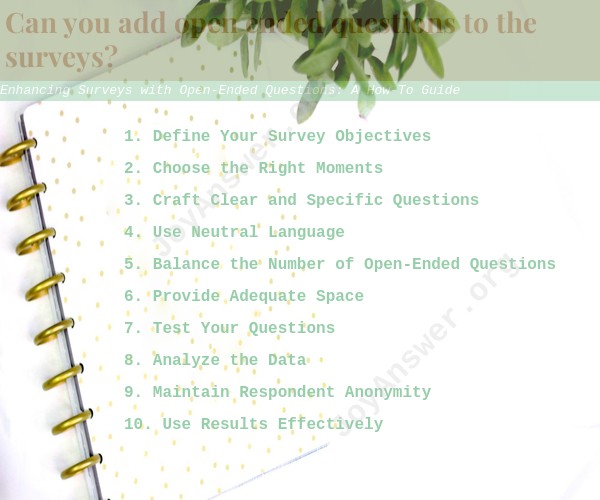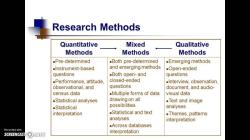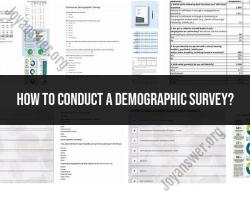Can you add open ended questions to the surveys?
Yes, you can and should include open-ended questions in surveys to gather qualitative data and gain deeper insights into the respondents' thoughts, opinions, and experiences. Open-ended questions encourage respondents to provide detailed and personalized responses, which can be valuable for understanding the "why" and "how" behind their choices or preferences. Here's a step-by-step guide on how to add open-ended questions to your surveys:
1. Define Your Survey Objectives:
- Determine the specific information you want to collect from respondents through open-ended questions. What insights are you hoping to gain? What aspects of the topic or issue do you want to explore in depth?
2. Choose the Right Moments:
- Identify appropriate points in your survey where open-ended questions can provide the most value. These questions should follow or complement closed-ended questions to gather detailed explanations or additional comments.
3. Craft Clear and Specific Questions:
- Open-ended questions should be clear and specific, so respondents understand what you're asking. Avoid overly broad or vague questions. For example, instead of "What do you think about our product?", ask "What specific features of our product do you find most useful, and why?"
4. Use Neutral Language:
- Ensure that your open-ended questions are neutral and do not lead respondents toward a particular response. Avoid biased or leading language that may influence their answers.
5. Balance the Number of Open-Ended Questions:
- Maintain a balance between open-ended and closed-ended questions in your survey. Too many open-ended questions can be time-consuming for respondents and may lead to survey fatigue.
6. Provide Adequate Space:
- Offer sufficient space for respondents to write their answers comfortably. If the space is limited, respondents may feel rushed and not provide as detailed responses as you'd like.
7. Test Your Questions:
- Before distributing the survey, test your open-ended questions with a small group of people to ensure clarity and understandability. Adjust the wording if needed.
8. Analyze the Data:
- Be prepared to analyze the qualitative data obtained from open-ended questions. This often involves reading through responses, categorizing common themes, and summarizing the findings. Consider using qualitative analysis software or manual coding to organize and interpret the data.
9. Maintain Respondent Anonymity:
- Assure respondents that their answers will remain anonymous and confidential. This can encourage them to provide more honest and candid responses.
10. Use Results Effectively:- Once you've collected and analyzed the open-ended responses, use the insights to make data-driven decisions or improvements based on the feedback. Share relevant findings with stakeholders and incorporate them into your strategies or actions.
Adding open-ended questions to surveys can provide a deeper understanding of your target audience and their perspectives. These responses can complement the quantitative data gathered from closed-ended questions and offer valuable qualitative insights for research, product development, customer feedback, and more.
Incorporating Open-Ended Questions in Survey Design
Open-ended questions are survey questions that allow respondents to answer in their own words. They are often used to gather qualitative data, such as opinions, beliefs, and experiences.
Open-ended questions can be incorporated into survey design in a variety of ways. They can be used as stand-alone questions, or they can be used as follow-up questions to closed-ended questions.
Benefits of Adding Open-Ended Questions to Surveys
Open-ended questions offer a number of benefits, including:
- They can help to gather more in-depth and nuanced data than closed-ended questions.
- They can help to identify new and unexpected insights.
- They can help to understand the "why" behind respondents' answers.
- They can help to build rapport with respondents and make them feel more valued.
Best Practices for Crafting Effective Open-Ended Questions
When crafting open-ended questions, it is important to keep the following best practices in mind:
- Be clear and concise. Avoid using jargon or technical language that respondents may not understand.
- Ask open-ended questions that are relevant to your survey topic.
- Avoid asking leading questions that may bias respondents' answers.
- Provide enough space for respondents to write their answers.
Analyzing and Utilizing Open-Ended Responses in Surveys
Once you have collected open-ended responses, you need to analyze and utilize them effectively.
One way to analyze open-ended responses is to code them. Coding is the process of assigning categories to responses. This can be done manually or using software.
Once the responses have been coded, you can use a variety of statistical methods to analyze them. For example, you can calculate the frequency of different codes, or you can look for patterns and relationships between codes.
Open-ended responses can be utilized in a variety of ways, including:
- To identify common themes and trends.
- To understand the reasons behind respondents' answers.
- To generate new hypotheses for further research.
- To improve your products or services.
Balancing Open-Ended and Closed-Ended Questions in Surveys
It is important to balance open-ended and closed-ended questions in your surveys.
Closed-ended questions are easier to analyze, but they can provide less in-depth data. Open-ended questions can provide more in-depth data, but they are more difficult to analyze.
The best balance of open-ended and closed-ended questions will vary depending on your survey goals and the type of data that you need to collect.
Here are some tips for balancing open-ended and closed-ended questions in your surveys:
- Use open-ended questions to gather in-depth data about respondents' opinions, beliefs, and experiences.
- Use closed-ended questions to gather data about demographics, preferences, and behaviors.
- Avoid using too many open-ended questions, as this can make your survey too long and tedious.
- Place open-ended questions at the end of your survey, so that respondents are more likely to complete them.
By incorporating open-ended questions into your survey design, you can gather more in-depth and nuanced data from your respondents. This data can help you to better understand their needs, wants, and pain points, which can lead to improved products, services, and customer experiences.













